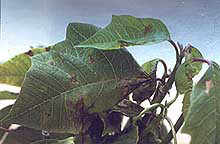A 4-day program was Developed to incorporate plant pathology into 8th grade science classrooms. We used teaching ideas from an Office of Public Affairs and Education (OPAE) workshop at the 2002 meeting of the American Phytopathological Society. Two of us (Amanda Core and Laura Wutz) are graduate students in the Department of Plant Pathology at Ohio State University. Ann Lighthiser, Academic Program Coordinator for our department, Ohio State graduate Jessica Baier, Columbus Public Schools Science Coordinator Patricia Bosh, and middle school teacher Steve Gipe also helped. Additional OSU undergraduate students helped us prepare the hands-on activities and assisted in teaching the 8th graders. To help fund the project, we received a grant of $3,125 from OPAE.
On the first day, we put on a skit involving three characters: the Manager and Assistant Manager of a grocery store (Giant Eagle) and the "Plant Detectives." The Assistant Manager noticed that many of the potatoes had sunken, black spots and smelled very bad. He alerted the Manager who called in the "Plant Detectives." The Plant Detectives asked questions such as where the potatoes came from and how they were shipped to Giant Eagle. They then explained how the "Disease Triangle" could be used to solve this mystery.
To look at the suspects and victim up close, we used two bags of jello (cytoplasm), one bag representing a bacterial cell and one a fungal cell, and one container of jello representing the plant cell. Different "organelles" were lying out on the table and students had to decide what goes into each cell. For example, a battery represented a mitochondrion and pantyhose represented a cell membrane.
On the second and third days, we asked the question, "What do these suspects look like?" We introduced them to the victim, a rotting potato, and the two suspects Erwinia carotovora (a bacterium) and Rhizoctonia solani (a fungus). The students wrote their observations and hypothesis on "who did it?" in their detective notebooks. Then they plated out the victim and two suspects onto agar plates.
We explained that the suspect could be disguised, so it is important to know what to look for at all times. To demonstrate this idea, they observed different stages of a water mold's life cycle under a microscope. To reemphasize the concept, pictures and words of a generalized life cycle were placed on magnets. Students then placed the magnets in the correct order on the board.
"Who did it?" On the last day, the agar plates were returned to the students. In groups, they determined which organism caused the potato to rot. This was accomplished by comparing the appearance of the agar plate from the rotten potato with the bacterial and fungal plates.
We gave the students motivational items throughout the process, such as a plant detective's journal for data, pencils, stickers and calculators to keep them interested in solving the mystery. These were all a big hit, especially the pencils!
We would like to thank the following groups who helped make this program a success: the Plant Pathology Department at Ohio State University, Columbus Public Schools, OPAE of APS, Giant Eagle, and the undergraduate volunteers from OSU.
For more information about this program, contact: Ann Lighthiser at 614-292-1375.
Plant Detective posters are available for free.
Lab resources:
Schumann, G.L. and C.A. Jasalavich. 2000. Water molds (Oomycetes). The Plant Health Instructor.
Schumann, G.L. 2002. Easy Demonstration of Fungal Mycelium. The Plant Health Instructor.
|

|
Views: Poinsettias. The very name conjures up visions of Christmas. Yet poinsettias are also afflicted by various diseases. One of the most severe of these diseases is Xanthomonas leaf spot caused by a bacterium.
|
